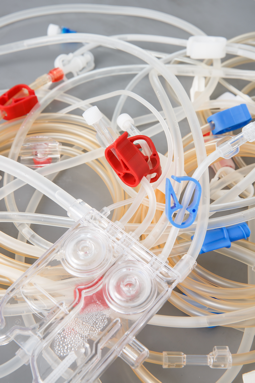
Multiple myeloma patients have a greater risk of kidney disease and specifically cast nephropathy (CN) due to the cancerous plasma cells’ production of antibodies known as immunoglobulins. Each immunoglobulin is made up of two long protein chains (heavy chains) and two shorter protein chains (serum-free light chains). In the majority of cases, kidney damage is caused by the accumulation and precipitation of these light chains which obstructs the blood vessels of the kidneys.
In patients with multiple myeloma, reduced kidney function has been associated with poor prognosis and shorter survival. Clinical research to improve kidney function is important in improving overall survival rates for multiple myeloma patients.
Dr. Ruben Niesvizky, Director at the Weill Cornell Medicine and NewYork-Presbyterian Myeloma Center, and Dr. Kenar Jhaveri, nephrologist and Professor of Medicine in the Division of Kidney Diseases and Hypertension at Hofstra and Northwell Health, published an editorial in the The Journal of the American Medical Association (JAMA) addressing the role of using a special form of hemodialysis in myeloma patients with kidney damage.
Hemodialysis cleanses and purifies the blood of a person whose kidneys are not functioning normally by removing waste, salt and extra water from the body. This process helps to maintain safe levels of chemicals and nutrients in the blood and to control blood pressure.
High-cutoff dialysis removes free light chains from the blood using a dialysis membrane with a higher molecular weight cut-off and very large membrane pores, as compared to conventional dialysis. One benefit of using the membrane with larger pore sizes is much faster removal of fluid. Drs. Niesvizky and Jhaveri discuss the impact of this approach and new research that indicates the temporary use of high-cutoff dialysis in myeloma patients could decrease the need for long-term dialysis and reduce overall mortality rates.
“The MYRE study was the first randomized clinical trial evaluating different type of hemodialysis in patients with a sudden episode of kidney failure, also known as acute kidney injury (AKI),” says Dr. Niesvizky.
Participants in the MYRE study received bortezomib, a proteasome inhibitor, and were randomized to receive intensive hemodialysis with either a high-cutoff dialyzer or a conventional high-flux dialyzer. The results showed that high-cutoff hemodialysis can effectively reduce high concentrations of circulating serum-free light chains in myeloma patients with dialysis-dependent AKI. At six months, significantly more patients in the high-cutoff group compared with the conventional group no longer required hemodialysis (56.5% versus 35.4%) and at 12 months the percentages increased to 60.9% and 37.5%, respectively. However, there was no difference in mortality at 12 months.
Although high-cutoff hemodialysis has been shown to be effective, it is not as widely available in the United States as it is in Europe. “While the MYRE study highlights the potential of using high-cutoff hemodialysis for this subset of myeloma patients, conducting further clinical trials and longitudinal studies is a next step in determining whether this intervention decreases the need for hemodialysis beyond the one-year mark. This data would help to better assess whether there’s a need to make the treatment more widely available to patients in the United States,” says Dr. Ruben Niesvizky.

